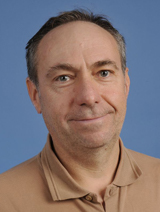Christophe Badie
Head of Department&Group Leader(Cancer Mechanisms and Biomarkers)
In this section

I am biologist who carried out my PhD in Radiobiology-Radiopathology at an cancer hospital, the Gustave Roussy institute in Villejuif near Paris which I obtained from the University of Paris XI - Orsay, France). Radiotherapy and many chemotherapeutics rely on DNA double-stranded break (DSB) formation to drive the killing of tumour cells over several cell division cycles but also damaging surrounding normal tissue cells. Using primary cultures of fibroblasts from patients, I worked on inter-individual radiation sensitivity and DSB repair. I identified the first radiotherapy patient whose radiation toxicity was due to a defect in DNA DSB repair which was thought to be almost incompatible with survival at the time; it was found later that the patient had a mutation in ligase IV. After several post-doctorate positions (one on p53 adenovirus and radiotherapy and one cell-cycle arrests following ionising radiation exposure), I became in 2005 the leader of the Cancer Mechanisms and Biomarkers group in the Radiation Effects department of Chemical, Radiation Environmental Hazards, UK Health Security Agency. Since 2023, I dedicate 50% of my time as head of the radiation effects department.
I have expertise in radiation carcinogenesis, especially leukaemia, developing models to detect cancers at an early stage early by tracking and monitoring the progression of initiated, 'pre-cancerous' cells (Verbiest T. et al. Leukemia 2018) or with a proneness to develop radiation-induced leukaemia (Brown N. et al. 2023) to get insight into the molecular mechanisms. I am interested in cancer genomics and the mutational signature left by ionising radiation in live cells and tissues. I have been associated with the first study on mutational signatures of ionizing radiation in second malignancies (Behjati S. et al Nature communications 2016). I have also interest in the effects of radiation exposure on the immune system as demonstrated by our recent publications on aging of the T-cell receptor repertoire (Candéias SM. et al. Cell Mol Life Sci. 2017) and on inflammatory gene expression following genotoxic cancer therapy (Manning G. et al Front Immunol. 2017);
Moreover, over the last 15 years, I have been working on the development of radiation biomarkers, mainly using human blood and more recently skin biopsies as sources of information. I worked on identifying and validating blood transcriptional biomarkers of radiation exposure which would be very useful in the event of a large-scale event leading to acute ionising radiation exposure where high-throughput methods would be required to rapidly assess individual biological dose estimates for triage purposes. We demonstrated its utility and robustness in several multi-centres' NATO and RENEB exercises. We recently performed nanopore sequencing to demonstrate that the technology can be used to detect radiation-inducible genes in human peripheral blood mononuclear cells (Cruz-Garcia L. et al. 2019). The technology can lead to the development of a portable device which can overcome issues involving sample shipment.
I am also very interested in new technical developments to identify sub-populations of blood cells and extracellular vesicles as a source of new biomarkers of radiation exposure, susceptibility and toxicity.
I have published extensively on these topics, with over 110 peer reviewed publications.
Other roles
I have been involved in many radiation protection research projects and have significant involvement in radiation research in Europe such as MELODI (European Multidisciplinary European Low Dose Risk Research InitiativeI am a member of the scientific committee of the International Association of Biological and EPR Radiation Dosimetry (IABERD) and RENEB (European network of biological dosimetry, Realizing the European Network of Bio dosimetry). I am also a member of the Research Orientation Committee of the French Institute of Radioprotection and Nuclear Safety (IRSN) and a member of the scientific committee of the ASN (French Nuclear Safety Authority). I serve on Committee 1 of the international Commission on Radiological Protection (ICRP).
|
Protecting and improving human health is at the heart of the biological research being carried out in the Cancer Mechanisms and Biomarkers group. More specifically, we are trying to better understand the mechanisms by which acute or protracted ionising radiation exposure either of natural or medical origin interact and affect cells and individuals.
|
Read more |